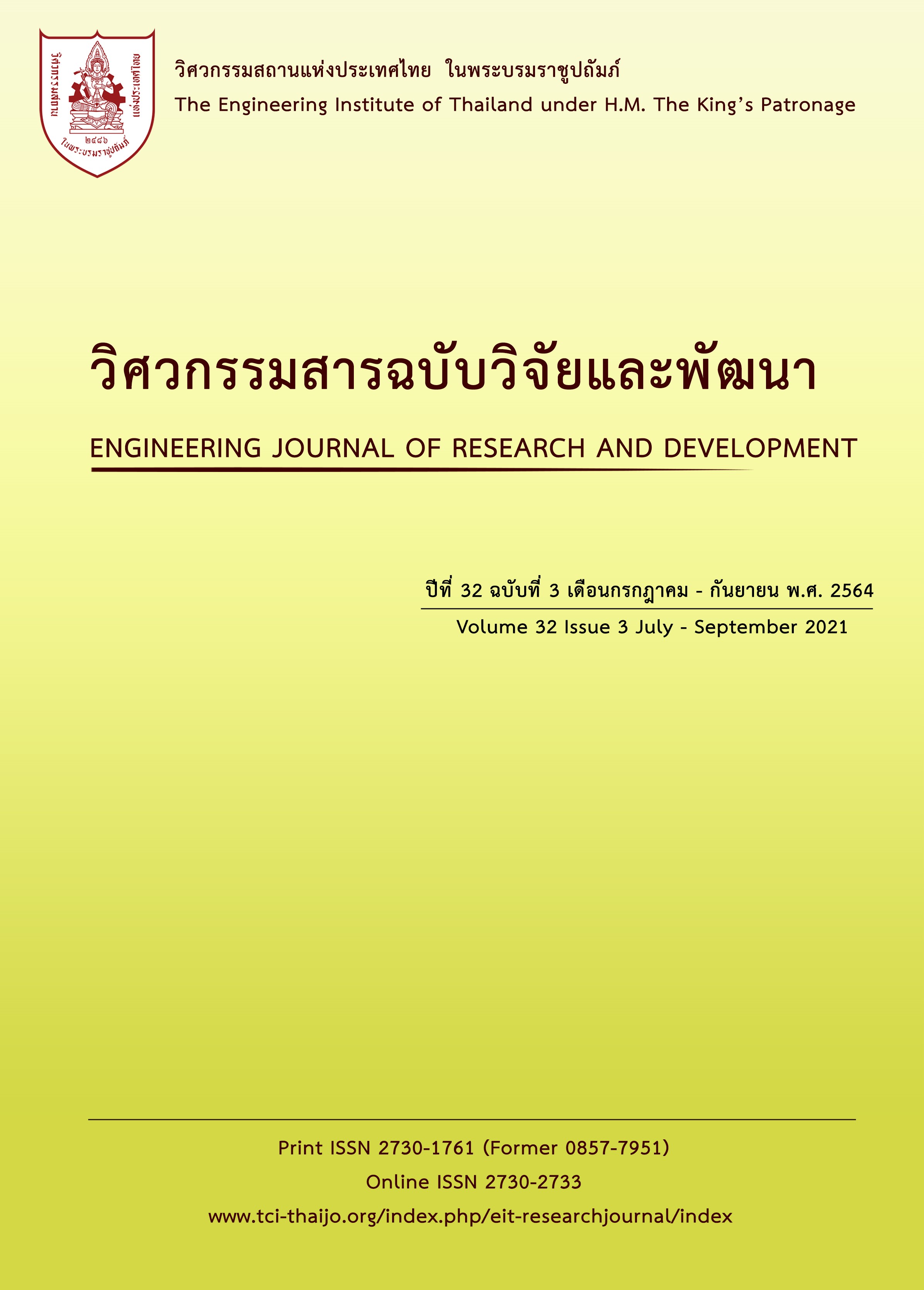SIMULATION OF MIXED-MODE FATIGUE CRACK PROPAGATION IN STEEL PLATES USING EXTENDED FINITE ELEMENT METHOD
Main Article Content
Abstract
This paper presents the simulation of mixed-mode fatigue crack propagation in steel plates and fatigue life prediction using the extended finite element method (XFEM). In the simulation, the interaction integral method was used to evaluate the stress intensity factors (SIFs) and the fatigue growth rate was based on the Paris’s equation. After validated with previous studies, the finite element models were used to investigate the effects of an initial crack angle on the crack path and fatigue life for the steel plate with an edge crack subjected to tension or bending. The simulation results showed that the crack path converged to the mode-I condition (zero angle) for all initial crack angles. Also, the fatigue life increased significantly when the initial crack angle was greater than 45 degree.
Article Details
The published articles are copyright of the Engineering Journal of Research and Development, The Engineering Institute of Thailand Under H.M. The King's Patronage (EIT).
References
Souiyah, M., Muchtar, A., and Ariffin, A.K. On the crack propagation trajectory of central cracked plates under mixed mode loading conditions, Key Engineering Materials, 2011, 462-463, pp. 154-159
Ismail, A.E. An Overview of Fracture Mechanics with ANSYS, International Journal of Integrated Engineering, 2018, 10(5), pp. 59-67
Walters, M.C., Paulino, G.H., and Dodds Jr., R.H. Interaction integral procedures for 3-D curved cracks including surface tractions, Engineering Fracture Mechanics, 2005, 72(11), pp. 1635-1663
Aygül, M., Al-Emrani, M., Barsoum, Z., and Leander, J. Investigation of distortion-induced fatigue cracked welded details using 3D crack propagation analysis, International Journal of Fatigue, 2014, 64, pp. 54-66.
Dinh, H.T. Analysis of Distortion-Induced Fatigue crack at the web gap of I-beam in steel bridges. Doctor's degree, Department of Civil Engineering Chulalongkorn University, 2012.
Triamlumlerd, W. Numerical simulation for fatigue crack propagation in steel beams with welded transverse stiffeners. Master’s thesis, Department of Civil Engineering Chulalongkorn University, 2015
Bouchard, P.O., Bay, F., and Chastel, Y. Numerical modelling of crack propagation: Automatic remeshing and comparison of different criteria, Computer Methods in Applied Mechanics and Engineering, 2003, 192(35-36), pp. 3887-3908
Fageehi, A. F. and Alshoaibi, A. M. Numerical Simulation of Mixed-Mode Fatigue Crack Growth for Compact Tension Shear Specimen, Advances in Materials Science and Engineering, 2020, 14
Mahmoud, H. N. and Miller, P. A. Distortion-induced fatigue crack growth. Journal of Bridge Engineering, 2016, 21(2), 04015041.
Huang, C., Chen, T., and Feng, S. Finite element analysis of fatigue crack growth in CFRP-repaired four-point bend specimens, Engineering Structures, 2019, 183, pp. 398-407
Chang, K. H. and Edke, M. S. Shape Sensitivity Analysis for 2D Mixed Mode Fractures Using Extended FEM (XFEM) and Level Set Method (LSM). Mechanics Based Design of Structures and Machines, 2010, 38(3), pp. 328-347
Singh, I.V., Mishra, B.K., Bhattacharya, S., and Patil, R.U. The numerical simulation of fatigue crack growth using extended finite element method, International Journal of Fatigue, 2012, 36(1), pp. 109-119
Lal, A. and Khatri, K. L. Mixed mode stress intensity factors of slanted edge cracked plate with hole subjected to various in-plane loadings using XFEM, International Journal of Materials and Structural Integrity, 2019, 13(1-3), pp. 110-124
Dirik, H. and Yalçinkaya, T. Crack path and life prediction under mixed mode cyclic variable amplitude loading through XFEM, International Journal of Fatigue, 2018, 144, pp. 34-50
Baptista, R., Santos, T., Marques, J., Guedes, M., and Infante, V. Fatigue behavior and microstructural characterization of a high strength steel for welded railway rails, International Journal of Fatigue, 2018, 117, pp. 1-8
Wang, C.S., Wang, Y.Z., Cui, B., Duan, L., Ma, N.-X., and Feng, J.Q. Numerical simulation of distortion-induced fatigue crack growth using extended finite element method, Structure and Infrastructure Engineering, 2020, 16(1), pp. 106-122
Hedayati, E. and Vahedi, M. Using Extended Finite Element Method for Computation of the Stress Intensity Factor, Crack Growth Simulation and Predicting Fatigue Crack Growth in a Slant-Cracked Plate of 6061-T651 Aluminum, World Journal of Mechanics, 2014, 4, pp. 24-30
Ru, Z.L., Zhao, H.B., and Yin, S.D. Evaluation of mixed-mode stress intensity factors by extended finite element method, Journal of Central South University, 2013, 20(5), pp. 1420-1425
Dolbow, J.E. An extended finite element method with discontinuous enrichment for applied mechanics. PhD dissertation, Northwestern University, USA, 1999
Moës, N., Dolbow, J., and Belytschko, T. A finite element method for crack growth without remeshing. International Journal for Numerical Methods in Engineering, 1999, 46, pp. 131–150.
Belytschko, T. and Black, T. Elastic Crack Growth in Finite Elements with Minimal Remeshing. International Journal for Numerical Methods in Engineering, 1999, 45, pp. 601-620.
Amir R.K. Extended Finite Element Method: Theory and Application, Wiley.2015.
Shih CF, Moran B, and Nakamura T. Energy release rate along a three-dimensional crack front in a thermally stressed body. International Journal of Fracture, 1986, 30, pp. 79–102.
S. K. Maiti. Fracture mechanics: fundamentals and applications, India: Cambridge University Press, 2015.
F. Erdogan and G. C. Sih, On the crack extension in plates under plane loading and transverse shear, Journal of Basic Engineering, 1963, 85(4), pp. 519–525.
BSI (British Standards Institution). Guide to methods for assessing the acceptability of flaws in metallic structures. BS 7910, London; 2013.
Huang, C., Chen, T., and Feng, S. Finite element analysis of fatigue crack growth in CFRP-repaired four-point bend specimens, Engineering Structures, 2019, 183, pp. 398-407.
Tada, H and Paris, P. C. and Irwin, G. R. The stress analysis of cracks handbook, 3rd ed. New York: ASME Press, 2000.
Hosseini, A., Nussbaumer, A., Motavalli, M., Zhao, X.-L., and Ghafoori, E. Mixed mode I/II fatigue crack arrest in steel members using prestressed CFRP reinforcement, International Journal of Fatigue, 2019, 127, pp. 345-361
Anderson TL. Fracture Mechanics: Fundamentals and Applications, 5th ed, CRC Press; 2005.
ASTM E647-15. Standard test method for measurement of fatigue crack growth rates. ASTM International; 2015.


